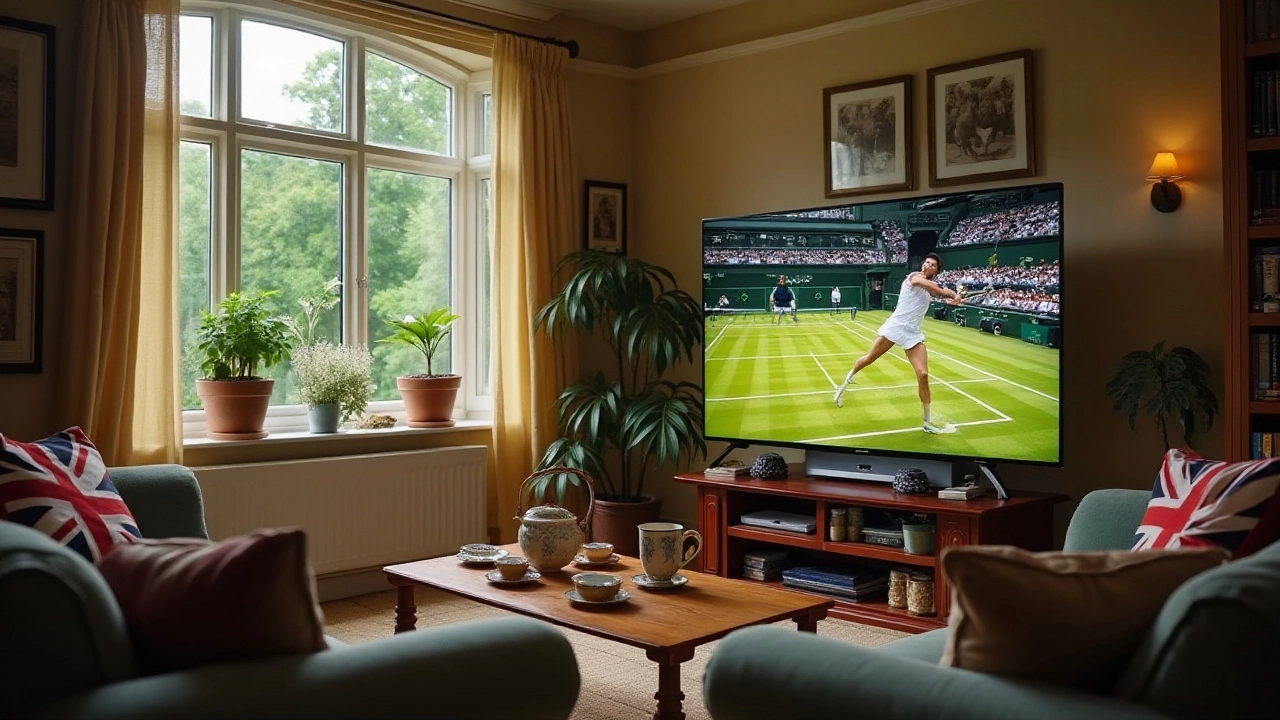
Tennis Tournaments January 23, 2025
Best Ways to Catch Live Tennis Tournaments on TV
Tennis, a sport that elegantly dances the line between power and precision, commands a global audience. The thrill of a break point, the intensity of a championship match–these are experiences best enjoyed live. Being able to catch these moments on television, from the comfort of your sofa, really adds to the enjoyment of the sport. But where should you turn if you want to watch all the major tennis tournaments? We’re diving into the best ways to experience tennis on TV in all its electrifying glory.
This guide takes you through everything you need to know about watching tennis tournaments on television. From understanding which networks hold the rights to various competitions across the calendar year, to knowing which streaming services might offer live broadcasts worldwide, we cover the horizon of tennis broadcast options. Get ready to fine-tune your sports-viewing schedule and ensure you don't miss any of the action on the court.
- Major Broadcasting Networks for Tennis
- Grand Slam Broadcasting Rights
- Streaming Services for Online Viewing
- Scheduling and Time Zones
- Tips for Enhancing Viewing Experience
- Future of Tennis Broadcasting
Major Broadcasting Networks for Tennis
When it comes to watching tennis tournaments on TV, major broadcasting networks play a pivotal role in bringing the exciting tennis action from courts to living rooms around the globe. There are a number of networks that hold broadcasting rights, ensuring tennis fans can tune into their favorite live tennis TV matches. Among these, ESPN stands out as a leader in sports broadcasting. They cover major events like the Australian Open and Wimbledon, offering insightful commentary and in-depth coverage, making it a go-to for many tennis enthusiasts.
The Tennis Channel is another key player in this space. Known for its comprehensive coverage of not only Grand Slam events but also ATP and WTA tours, it provides tennis content almost year-round. For those in the UK, the BBC offers extensive coverage, particularly when it comes to the much-celebrated Wimbledon Championships. Meanwhile, in Europe, Eurosport dominates the tennis airwaves with its detailed and engaging broadcasts of major tournaments.
"The way we consume sports like tennis on TV has transformed remarkably. It's not just about watching the game, but experiencing it as if you are sitting courtside," remarked a sports broadcasting expert.
It's worth noting the significant efforts made by these networks to not only broadcast the matches but also enrich the viewer experience. With high-definition video, expert analysis, and player interviews, they create a dynamic viewing environment. In addition to traditional TV broadcasts, these networks are embracing digital transformation, allowing fans to stream matches online, often through dedicated apps or websites, making it more convenient for fans all over.
Here is a quick look at some of these networks and their remarkable reach:
| Network | Regions | Main Tournaments Covered |
|---|---|---|
| ESPN | Global, especially USA and Latin America | Australian Open, Wimbledon |
| BBC | United Kingdom | Wimbledon |
| Eurosport | Europe | French Open, US Open |
| Tennis Channel | USA | ATP Tours, WTA Tours |
Aligning with technological advancements, many of these major broadcasters now provide additional services like highlights, expert analysis, and exclusive interviews through online platforms and social media channels. This multi-channel strategy not only keeps viewers engaged but also allows them deeper insights into the game and its players. As tennis continues to captivate audiences worldwide, having access to these dedicated networks ensures that fans stay intimately connected to every serve, volley, and match point.
Grand Slam Broadcasting Rights
The Grand Slam tournaments hold an esteemed position in the world of tennis, captivating audiences with their blend of history, prestige, and top-tier skill. These events include the Australian Open, French Open, Wimbledon, and the US Open. Each tournament, with its unique setting and tradition, attracts viewership worldwide, creating a bustling marketplace for broadcasting rights. The allocation of these rights is a major business involving lucrative deals. For instance, in the UK, the BBC has long been synonymous with Wimbledon, providing extensive coverage free of charge to viewers. This ensures that millions can enjoy the iconic tournament without a subscription, a privilege not afforded by all networks.
In contrast, the US Open is accessible through different networks depending on the region. ESPN is the primary broadcaster within the United States, but international audiences may need services like Eurosport or Sky Sports. Each network competes vigorously for these rights to capitalize on the Grand Slam’s widespread popularity. The financial stakes are high, with broadcasters often paying substantial amounts to secure exclusivity. Indeed, Tennis Australia renewed Channel Nine's broadcasting rights for the Australian Open in a multi-million-dollar deal, ensuring comprehensive coverage that spans main draws, player interviews, and analysis. As John McEnroe once wisely noted in an interview, "Television is the lifeblood of tennis. It takes the excitement and drama of the sport into homes around the world."
Let's not forget the technological advancements shaping how tennis is viewed. Streaming platforms often supplement traditional broadcasting, offering a digital alternative that caters to on-the-go audiences. This flexibility is particularly useful for international fans dealing with varying time zones during events like the French Open. Employing ITV's terrestrial services and online platforms creates a seamless transition from television sets to mobile devices, ensuring accessibility without geographical restrictions. Moreover, the advent of online streaming has altered the dynamic of bid placement and broadcast rights acquisition. Contracts now frequently include multi-platform deals to maximize outreach, signaling a shift from television exclusivity to a more integrated viewing experience.
Interestingly, as contracts evolve, broadcasting rights for the Grand Slam tournaments create ripple effects that influence partnerships globally. These agreements serve as benchmarks for international networks seeking to solidify their market position. The competitive environment necessitates strategic collaborations, such as France Télévisions' partnership with Eurosport for the French Open, enabling cohesive viewing experiences across digital and linear mediums. As a result, there's an increased emphasis on tailored coverage that captures the tournament's enduring allure while meeting modern consumer demands. Networks strive to offer not just live matches, but also a plethora of supplementary content, from pre- and post-match analysis to player documentaries.
Beyond the financial narrative lies the cultural impact that broadcast decisions can have. As more territories vie for content, the accessibility of the Grand Slam events often determines the sport’s regional popularity and encourages global fandom. The ability to watch a mesmerizing rally in real-time or catch a gripping five-setter in its entirety fosters a connection between the viewer and the sport. Broadcasting rights thus play a pivotal role not just in monetary terms but in shaping the worldwide tennis community. A wise philosopher once mused that sport brings people together, and nowhere is this truer than in the universality and unity of Grand Slam viewership.
Looking towards the future, it is clear that the Grand Slam broadcasting landscape will continue to evolve, driven by technological advances and audience preferences. As streaming giants make bids and traditional networks strive to maintain their foothold, the ultimate winners of this dynamic interplay are the fans, who gain more access points and richer tennis experiences. With the right strategic maneuvers, the seamless integration of TV and digital streaming can elevate the tennis experience, keeping the timeless charm of Grand Slam tournaments alive in an ever-changing world.

Streaming Services for Online Viewing
In the modern era, catching tennis tournaments is no longer confined to traditional television. As technology advances, an increasing number of fans turn to online options to watch tennis live. Streaming services have risen to the occasion, offering flexible, on-the-go ways for viewers to immerse themselves in their favorite sport. Whether you're at home or on the move, these platforms ensure you never miss a pivotal moment on the court.
Several streaming services have capitalized on the digital audience's thirst for tennis action, featuring a variety of ways to catch the games. One popular service is Tennis TV, which offers coverage of major ATP tournaments throughout the season. With a subscription, fans gain access to live matches and extensive highlights that keep them in the loop.
Tennis.com notes, "For true fans, Tennis TV is more than just a viewing platform; it's a community where they can connect over shared passion."Not to be outdone, Amazon Prime Video has secured broadcasting rights to numerous WTA events, blending the flexibility of its service with the thrill of live sports.
Formerly known as ESPN+, the newly rebranded service carries a range of tennis matches, making it a reliable hub for fans in the United States. Not only does it provide live streams, but it also offers on-demand viewings that cater to fans juggling busy schedules. Additionally, DAZN has emerged as a powerhouse in sports streaming, particularizing in broadcasting high-stakes matches from celebrated tournaments like Wimbledon and the US Open.
In the realm of online viewing, navigating time zones can often pose a challenge for audiences intending to catch live matches. Streaming platforms enhance this experience through advanced scheduling features that allow users to customize alerts for upcoming matches. Some services even offer reruns for those unable to tune in live. These digital perks streamline the viewing experience, ensuring fans don't miss a single ace or rally, regardless of geographic timing.
Modern-day streaming platforms are also taking steps to simulate the courtside experience. With features such as multi-angle viewing, commentary options, and interactive apps, they bring the tennis action to life in vivid detail. This digital ecosystem not only fulfills the demand for flexibility but also adds layers of engagement that traditional viewing options may lack. Streaming services have undeniably revolutionized how we watch tennis, shaping a landscape where accessibility and immersion coexist.
While the array of available options offers substantial benefits, fans must also consider potential pitfalls. Subscription costs and region-specific restrictions can sometimes erect barriers for viewers. Consequently, researching services that offer the best value for your intended viewing range is crucial. Online forums and reviews often present helpful insights and tips from seasoned subscribers, allowing prospective users to make informed decisions. As technology continues to evolve, the prospect of augmented reality and 4K streams suggests an even brighter future for tennis enthusiasts worldwide.
Scheduling and Time Zones
When it comes to enjoying your favorite tennis tournaments on television, scheduling, and time zones play a critical role. Tennis matches occur across different continents, making it crucial to understand the time zone differences so that you don't miss a single match point or epic rally. Different tournaments occur in places stretching from New York for the US Open to Melbourne for the Australian Open, each situated in unique time zones that significantly impact broadcast times.
For instance, the Australian Open takes place in Melbourne, which operates on AEDT (Australian Eastern Daylight Time). If you're watching from the UK in GMT (Greenwich Mean Time), there's approximately an 11-hour time difference during daylight savings time. Therefore, matches that begin in the evening in Melbourne might be live in the early morning for viewers in the UK. This means setting an early alarm or staying up late to catch your favorites in action, depending on your preference.
Grand Slam titles aren't the only tournaments to consider; you'll find ATP and WTA tours filling the calendar year. The French Open, held in Paris, is on Central European Summer Time (CEST), and offers more convenient viewing hours for Europeans. Yet, if you're Stateside, you'll need to adjust to tune in live, often meaning early morning sessions to witness the clay court combat. The tennis broadcast networks often provide replays or highlights during standard viewing times to cater to broader audiences.
To keep track of all this, tennis fans prefer using broadcast schedules provided by major network websites or third-party apps specifically designed for sports viewing. These applications display real-time schedules and also let viewers set reminders for the matches they don't want to miss. They are functional and become particularly handy when tournaments overlap.
"Adjusting to different time zones isn't easy, but the joy of watching Federer glide effortlessly on grass at Wimbledon is worth waking up to." – Tennis World Magazine
With technology, television isn't the only medium; a slew of digital streaming services now allows you to live stream matches on various devices. They accommodate time zone differences by offering delayed broadcasts or catches up services, adding flexibility to your tennis-watching routine. Given the array of options, it’s beneficial for fans around the world. Whether a match takes place under the bright Californian sun during the Indian Wells or in the humid evening in Rio, you can comfortably tune in from virtually anywhere. Besides, it's becoming more common for streaming platforms to sell 'match-passes' for particular games for nominal fees, ensuring tennis becomes more accessible to all.
Time Zones and Their Impact on Broadcast Viewership
Moreover, understanding time zones not only affects individual viewers but also broad influences broadcast schedules for channels around the world. The ability of a network to capitalize on peak viewing hours significantly impacts viewership ratings and sponsorship deals. The 'prime-time' broadcast slot varies in its definition depending upon the region. For instance, in the United States, east coast audiences are a priority, and networks strive to cater match timings accordingly, often negotiating with tournament organizers to schedule the marquee matches during these slots for maximum reach. Watch tennis when demand is highest to drive network success and provide viewers with thrilling live sports action that aligns with everyday life routines. This necessity to align with optimal timeframes underscores the importance of fluid communication between broadcasters, event organizers, and consumer demands.When planning your next live viewing, ensure you check whether daylight savings might also impact your time conversions. Not every region complies with this practice, resulting in an additional hour shift that can lead to mishaps if not considered. A quick online check or a time-converting app can prove to be indispensable in perfectly timing your tennis watching experience. That way, you'll always catch the first serve instead of the post-match wrap-up.

Tips for Enhancing Viewing Experience
Watching a thrilling match where the tennis ball zips across the court isn’t just about sitting in front of a screen. It’s about embracing the excitement and honing the experience at home to feel just as vivid as it would from the tournament stands. Let’s explore some clever ways to amplify your tennis-watching moments. One effective approach is to upgrade your home theatre setup. A good-sized television with a high refresh rate makes those fast-paced serves and volleys clear and smooth. If your budget allows, consider investing in surround sound speakers or a soundbar to catch every grunt, swoosh, and audience cheer with clarity. A subtle adjustment to the room ambiance using dimmable lighting can also add to the cinema-like feel right in your living room. Don’t forget about the comfy couch set up; a bit of relaxation can go a long way during those long five-set matches.
Engaging in Interactive Platforms
Thanks to technological advancements, several interactive platforms elevate the live tennis viewing experience. One might wonder what more could be done while glued to the TV. Add interactivity by syncing your broadcast with your favorite second-screen experiences. Use official tournament apps which often provide commentary, player stats, or real-time scores. You can even join online forums or Twitter discussions to share the thrill with other enthusiasts in real-time. Engaging with these platforms adds a social element, creating a sense of community among viewers worldwide. Not only does it offer a chance to engage in lively debates over calls and predictions, but it also expands your understanding of the game.
Pre-match Preparation
Preparation is key to fully understand and appreciate watching tennis anyone can enjoy. Before tuning in, why not spend a little time learning about the players and rivalries? Check out their last few performances, injuries, strengths, and weaknesses as it gives context to the game. Having a background knowledge often sparks greater interest in watching the matches unfold. You can also get familiar with the specific tournament’s history, surface types, and famous moments, births richer appreciation of the event. If you're among those who enjoy a bet or two, it might be rewarding to analyze odds and player forms that often add an extra layer of anticipation as points rack up.
Healthy Snacks and Drinks
No sports viewing is complete without a selection of delightful snacks. Instead of reaching for typical junk food, why not enhance the experience with a spread of healthy options? Fruits, veggies, nuts, or a flavorful salad with grilled chicken make great alternatives for the usual game-time treats. Hydration is just as crucial; consider preparing smoothies or fresh beverages to keep you energized through the roller-coaster of emotions a match often brings. Transforming your snack game not only proves healthier but becomes an experience in its right as you sip an ice-cold drink or munch on a crispy snack in moments when the tension is palpable.
Event Theming
If you are hosting friends or family to watch the big final, why not take it a step further by theming the event? Create a mini-wimbledon right at home with decorations, themed snacks like strawberries and cream, or even a friendly wager on match outcomes. Inviting people adds more dimensions to the experience, sharing the highs and lows with others rekindles the sense of communal excitement seen in stadiums. A recent survey found that 60% of tennis fans enjoy matches more when viewed socially, enhancing the roaring support atmosphere.
With these personalized touches, from technological setups, nutritious snacks, and social engagements, watching tennis tournaments on TV can transform into an extraordinarily enjoyable pastime, making you feel like a part of every serve and rally, right from your home base.
Future of Tennis Broadcasting
The digital age is transforming how we consume sports, and tennis is no exception. With advancements in technology reshaping the landscape of tennis broadcasting, fans can expect a more immersive and interactive viewing experience. Innovations such as virtual reality (VR) and augmented reality (AR) are poised to bring viewers courtside, offering new perspectives on the game. Imagine watching a match with a 360-degree view, feeling as though you're in the crowd at Wimbledon or near the net at Roland Garros. These technologies aren't just science fiction; they're actively being developed and fine-tuned to enhance the viewer's experience in the near future.
The integration of streaming services with traditional broadcasting also plays a pivotal role in the evolution of tennis viewership. As live tennis TV moves beyond the confines of cable, streaming platforms offer greater accessibility and flexibility. According to recent statistics, more than 60% of sports viewers now rely on digital platforms to catch their favorite matches, indicating a shift in consumer habits. Companies like Amazon Prime and ESPN+ have already secured deals to stream major tennis events, ensuring fans can watch matches on-demand, on any device, anywhere in the world.
"The key to the future of sports broadcasting lies in creating a seamless and personalized viewer experience," says technology analyst Mark Hughes. "Sports networks are investing heavily in data analytics and AI to deliver content that aligns with viewer preferences and enhances engagement."
Looking ahead, broadcasters are increasingly emphasizing interactive features. Imagine being able to toggle between different camera angles during a match, access player stats in real-time, or engage with live commentary through social media integration. These features are becoming part of the standard viewer package, providing a more enriched and involved experience for tennis fans. Additionally, the employment of artificial intelligence is expected to help in generating real-time insights, offering fans unprecedented access to performance analytics, predictive match outcomes, and personalized highlights.
Moreover, as 5G technology becomes more ubiquitous, it promises to revolutionize the way live sports are covered and consumed. With its unparalleled speed and low latency, fans can expect smoother, high-definition streams without delays or buffering, even in areas with heavy network traffic. This technology not only enhances the quality of the broadcast but also enables new forms of interaction, such as instantaneous replays and ultra-high-definition content. As broadcasters adapt to these new possibilities, the line between being at the venue and watching from home continues to blur.
In short, the future of tennis broadcast is bright, dynamic, and filled with possibilities. The convergence of traditional networks with new media technologies promises not just greater accessibility but also a richer, more engaging viewer experience. As the demand for personalized and interactive content grows, tennis fans stand at the brink of a revolutionary shift in how they connect with the sport they love.




